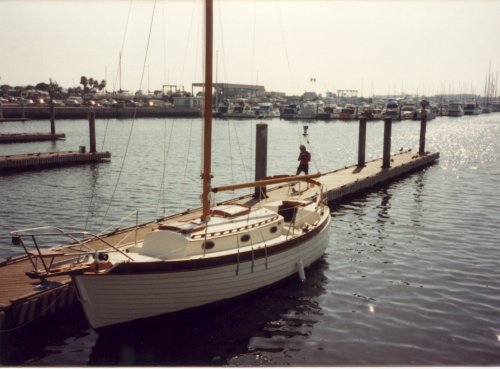If sailing in beautiful and exotic parts of the world ranks high on your “wish to do” list, but sailing to beautiful and exotic parts of the world doesn’t—read on.
Designed by the late Lyle Hess, the Nor’Sea 27 was conceived by company founder Dean Wixom to be capable of sailing anywhere in the world yet be reasonably transportable from one destination to another, if one chose to do so. Of only several vessels that could be said to fit this niche market, none is more highly regarded than the Nor’Sea 27. The model is best described as “transportable” because, although the eight-foot beam allows trailering without special permit, at more than 10,000 pounds (boat and trailer) a full size truck is needed for the job. And, although the mast has a tabernacle base for raising and lowering without yard support, it takes several hours for an experienced owner to get the rig up and ready for sailing.
The lapstrake hull of the Nor’Sea 27 is constructed of alternating layers of 1 ½ -ounce fiberglass mat and 18-ounce woven roving with polyester resin. Laminate thickness varies from 5/16 inches at the sheer to 3/4 of an inch at the keel. Although the lapstrake hull is considerably more costly and time consuming to build, it does add a salty appearance and some strength to the overall structure. Ballast is 3100 pounds of internal lead, so there is no concern for maintaining keel bolts.
The deck is fiberglass with plywood core for strength and stiffness and joined to the hull with adhesive sealants and stainless steel bolts on six-inch centers. Fiberglass liners and plywood bulkheads combine to provide the necessary structural reinforcement. Bottom line—one would be hard pressed to find a more stoutly built 27-footer.
The Nor’Sea 27 is offered with aft or center cockpit deck arrangement plan. Both models feature a teak bow pulpit with dual anchor rollers and a recessed, well-like foredeck. Side decks are necessarily quite narrow but secured by double lifelines and well-supported stainless steel stanchions and rails. The cockpit is quite tight for more than two people but in a pinch can accommodate up to four adults. Deck hardware, hatches, and ports are all top quality bronze or stainless steel. Cockpit and foredeck scuppers are 1 ½ -inch diameter so that any water that comes aboard drains quickly and will not overwhelm the boat.
The more popular center cockpit model allows for a slightly more functional interior arrangement and greater storage volume. Over the years there were slight changes in arrangements, but generally the main saloon features a dinette forward that converts to a comfortable double berth when the table is lowered. There are a fully enclosed head and chart table to the port side and the galley to starboard with gimbaled stove and oven, stainless steel sink, and ice box. The aft cabin is accessed from the cockpit and is for storage and sleeping only. It features two comfortable sea berths and lots of volume for storage. The aft cockpit version has a similar arrangement forward, although the trunk cabin is slightly longer, and there are port and starboard quarter berths.
Nor’Sea offers the 27 to new boat purchasers in various stages of construction from basic hull, deck, bulkheads, ballast, and rudder to completely finished. For this reason, layout and quality of the finished product can vary considerably. Factory finished boats are done to a very high standard.
On most Nor’Sea 27s, auxiliary power is provided by a two cylinder Yanmar engine fit beneath the cockpit deck. Although access is tight, the installation is very well done, the area is well insulated against noise and vibration, and a 30-gallon fuel tank provides excellent range under power.
Boats of this type should not be evaluated on sailing performance alone but on a combination of sailing performance and comfort. When both are considered, the Nor’Sea 27 is quite impressive indeed. Her “Comfort Ratio,” 32, is the highest of any 27-foot boat I have ever calculated. The hull is narrow, easily driven, and tracks well. Two rig options were offered, and both are deck-stepped, single spreader, masthead arrangements. Although the tall rig (34’) offers slightly more sail area than the standard rig (30’ 6”), there is not a significant difference in speed and performance. If there is a complaint, it is that balance is a bit fussy, and it’s difficult to leave the helm unattended.
Unfortunately, all of this versatility and quality isn’t cheap. A new, factory-finished Nor’Sea 27 is nearly $150,000, although kits start at less than $35,000. The cost of used models varies considerably depending on age, condition, and quality of finish. In October of 2006, I found 10 used Nor’Sea 27s offered for sale with asking prices ranging from $28,000 for a 1981 model to $95,000 for a 2000 model. Reported sales for the last six months ranged from $19,500 for a 1978 boat to $61,500 for a 1994 model. On average, 40% of the listed and sold boats included trailers. The cost to replace a trailer could be as much as $9000, so the condition of any trailer should not be overlooked when considering a purchase.
The transportability that permits spending a winter in the Bahamas followed by summer in the San Juans and fall on the Chesapeake Bay is the primary appeal of the Nor’Sea 27. However, if you actually enjoy offshore passages in small boats, the Nor’Sea 27 has proven capable on many offshore passages and at least a handful of circumnavigations.
Reviewed in the December 2006 issue of SpinSheet by Jack Hornor





